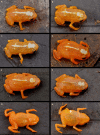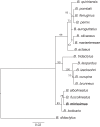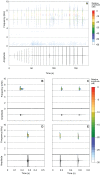A new species of Brachycephalus (Anura: Brachycephalidae) from southern Brazil
- PMID: 30310742
- PMCID: PMC6174073
- DOI: 10.7717/peerj.5683
A new species of Brachycephalus (Anura: Brachycephalidae) from southern Brazil
Abstract
A new miniaturized frog of the genus Brachycephalus (Anura: Brachycephalidae) is described from Morro Santo Anjo in the municipality of Massaranduba, Santa Catarina, southern Brazil. Specimens were collected from the leaf litter between 470 and 540 above sea level. The new species is distinguished from all its congeners by the combination of the following characters: (1) body robust and bufoniform; (2) size snout-vent length 9.9-11.7 mm for males and 10.0-12.9 mm for females; (3) smooth dorsum; (4) general color (in life) orange with white dots and stripe in the middle of the head and along its vertebral column; (5) iris completely black; (6) advertisement call composed of note groups; (7) isolated notes with 1-3 pulses; and (8) short isolated notes (0.002-0.027 s). An estimate of the male density of the new species is also presented. Phylogenetic information indicates that the new species is part of the southernmost clade of Brachycephalus, which includes Brachycephalus fuscolineatus, B. albolineatus, and B. boticario. The severe anthropogenic impacts in and around the type locality indicate that immediate actions should be taken to ensure the long-term preservation of the new species.
Keywords: Atlantic forest; Brachycephalus mirissimus; Brachycephalus pernix group; Conservation; Linea masculina; Montane forest; Note-centered approach; Serra do Mar.
Conflict of interest statement
Marcio R. Pie is an Academic Editor for PeerJ.
Figures









References
-
- Araújo CBD, Guerra TJ, Amatuzzi MCO, Campos LA. Advertisement and territorial calls of Brachycephalus pitanga (Anura: Brachycephalidae) Zootaxa. 2012;3302(3302):66–67.
-
- Bioacoustics Research Program . Ithaca, NY: The Cornell Lab of Ornithology; 2012.
-
- Bornschein MR, Firkowski CR, Belmonte-Lopes R, Corrêa L, Ribeiro LF, Morato SAA, Antoniazzi RL, Jr, Reinert BL, Meyer ALS, Cini FA, Pie MR. Geographic and altitudinal distribution of Brachycephalus Fitzinger (Anura: Brachycephalidae) endemic to the Brazilian Atlantic Rainforest. PeerJ. 2016a;4:e2490. - PMC - PubMed
-
- Bornschein MR, Maurício GN, Lopes RB, Mata H, Bonatto SL. Diamantina Tapaculo, a new Scytalopus endemic to the Chapada Diamantina, northeastern Brazil (Passeriformes: Rhinocryptidae) Revista Brasileira de Ornitologia. 2007;15(2):151–174.
LinkOut - more resources
Full Text Sources
Miscellaneous

